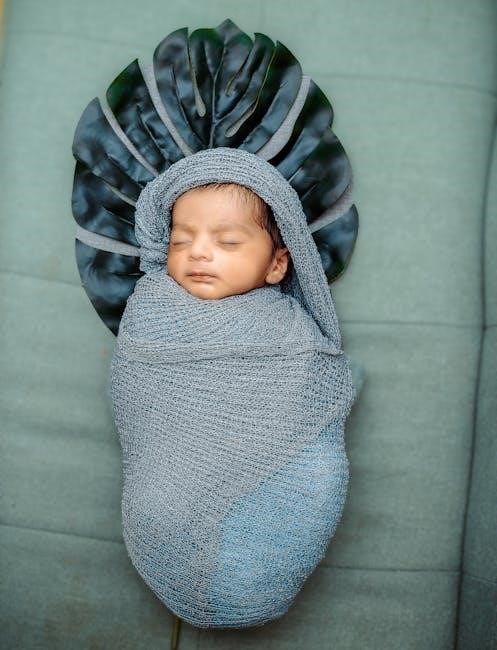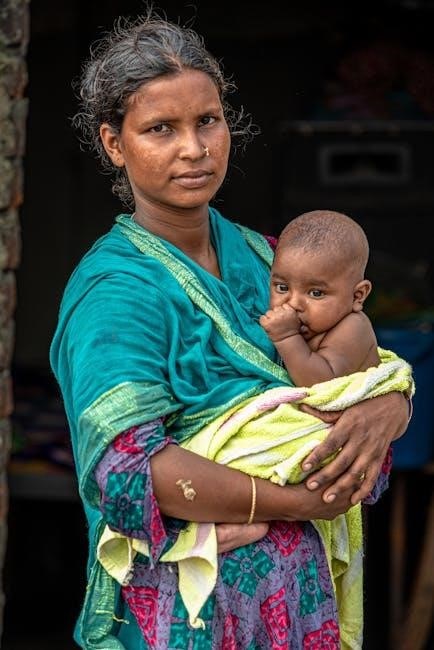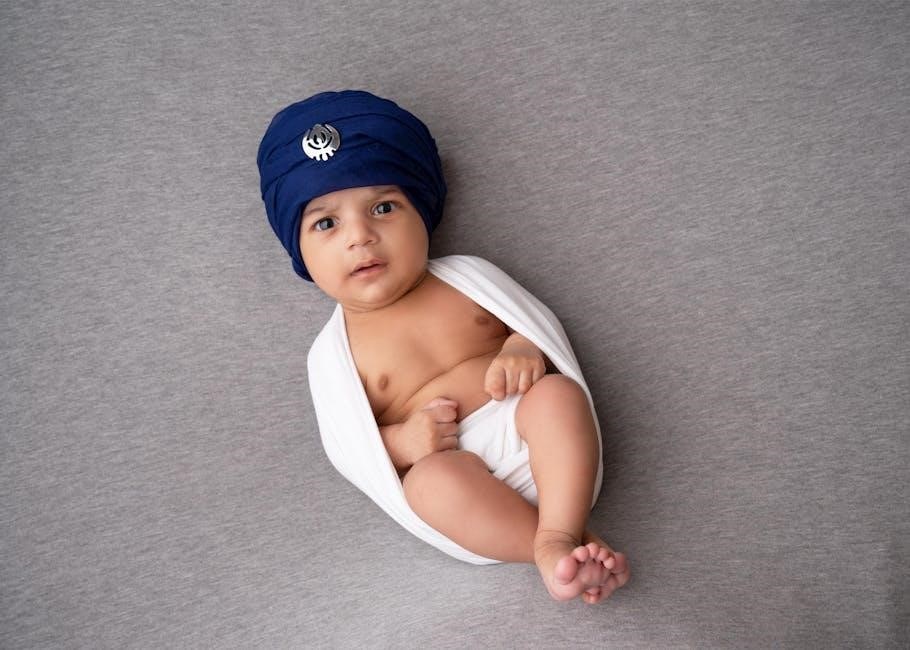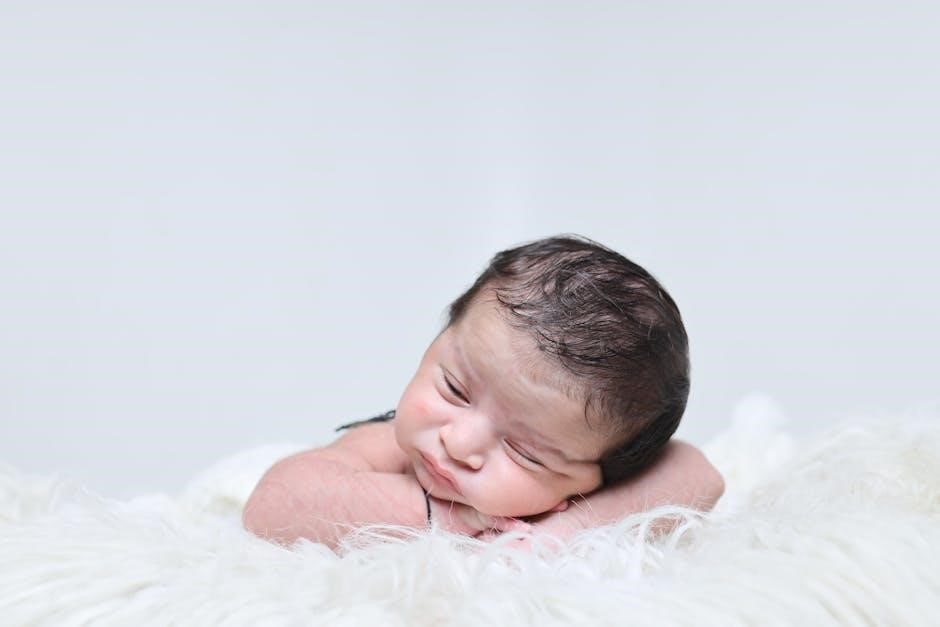A baby wrap is a simple tool for carrying your little one close, keeping your hands free; This guide offers step-by-step instructions, safety tips, and expert advice to help you master babywearing confidently and comfortably․
1․1 What is a Baby Wrap?
A baby wrap is a simple, versatile fabric tool designed to carry your baby close to your body, allowing you to keep your hands free․ Typically made of stretchy or woven material, it wraps around your torso and securely holds your baby in a snug, upright position․ Unlike structured carriers, a baby wrap is fully adjustable, making it suitable for newborns through toddlers․ It promotes bonding and convenience, enabling parents to manage daily tasks while keeping their little one comfortable and secure․ The wrap is tied in a way that distributes the baby’s weight evenly, ensuring comfort for both wearer and child․

1․2 Benefits of Using a Baby Wrap

Using a baby wrap offers numerous benefits for both parents and babies․ It promotes bonding by keeping your little one close, fostering a sense of security and comfort․ The wrap allows for hands-free parenting, making it easier to manage daily tasks while caring for your baby․ It is also highly versatile, suitable for newborns through toddlers, and can be adjusted to accommodate different carrying positions․ Additionally, baby wraps are lightweight and portable, making them a practical choice for outings․ They also provide even weight distribution, reducing strain on the wearer’s back and shoulders, ensuring comfort for both parent and child․
1․3 Importance of Proper Baby Wrapping Techniques
Proper baby wrapping techniques are essential for ensuring your baby’s safety, comfort, and proper support․ Incorrect wrapping can lead to discomfort or even safety risks, such as the baby slouching or their legs not being properly positioned․ By following correct methods, you ensure your baby is secure, with their knees slightly above their bum and their spine aligned․ This promotes healthy hip development and prevents strain on their joints․ Proper techniques also distribute the baby’s weight evenly, reducing discomfort for the wearer․ Mastering these techniques is key to enjoying the full benefits of babywearing while keeping your little one safe and content․

Types of Baby Wraps
Baby wraps come in various styles, including stretchy, woven, and Mei Tai wraps․ Each type offers unique features, such as flexibility, durability, or ease of use, catering to different preferences and needs․
2․1 Stretchy Wraps
Stretchy wraps are a popular choice for newborns and young infants, offering a soft, elastic material that provides a snug and comfortable fit․ They are easy to use, as they don’t require complex tying and can be pre-tied for convenience․ Ideal for quick errands or around the house, stretchy wraps allow for easy in-and-out access, making them perfect for new parents․ However, they may lack the structured support of woven wraps and are typically recommended for the first few months․ Many parents appreciate their simplicity and versatility, making them a great introduction to babywearing․
2․2 Woven Wraps

Woven wraps are a popular choice among babywearers due to their durability and versatility․ Unlike stretchy wraps, they are made from non-stretch, woven fabric, offering excellent support for both baby and wearer․ Woven wraps are suitable for a wide range of ages, from newborns to toddlers, and can be used in various carrying positions, such as front, hip, and back carries․ They often require precise sizing to ensure a proper fit and may have a learning curve for beginners․ However, their structured design and adjustable features make them a favorite for many experienced babywearers seeking long-term comfort and support․
2․3 Mei Tai Wraps
Mei Tai wraps combine the simplicity of a wrap with the structure of a carrier, offering a hybrid design․ They typically feature a rectangular panel with straps that tie around the wearer’s body, providing a snug and customizable fit․ Unlike woven or stretchy wraps, Mei Tai wraps often have a built-in waistbelt and shoulder straps, making them easier to use for some parents․ They are known for their comfort and versatility, allowing for front and back carries․ Mei Tai wraps are a great option for those who want the benefits of a wrap without the complexity of fabric manipulation, making them ideal for both beginners and experienced babywearers․
Safety Considerations
Ensure your baby’s airway remains unobstructed, with their face visible and chin off their chest․ Always follow the TICKS rule and perform regular safety checks before and during use․
3․1 General Safety Guidelines

Always ensure your baby’s face is visible and their chin is not pressed to their chest․ Keep their airway unobstructed and avoid covering their head or neck․ Use the TICKS rule: Tight, In view, Close enough to kiss, Comfortable, and Supported․ Regularly check the wrap for any damage or wear․ Ensure the baby’s knees are slightly above their bum for proper positioning․ Avoid overheating by dressing your baby in lightweight clothing․ Never leave your baby unattended while they are in the wrap․ Follow the manufacturer’s instructions and practice wrapping techniques to build confidence and ensure safety․
3․2 The TICKS Rule for Babywearing
The TICKS rule is a essential guideline for safe babywearing: Tight, In view, Close enough to kiss, Comfortable, and Supported․ Ensure the wrap is snug but not restrictive, keeping your baby upright․ Always maintain a clear view of your baby’s face to monitor their breathing․ Keep your baby close enough to kiss, ensuring their head is at a safe distance from your chest․ The wrap should feel comfortable for both you and your baby, with proper support for their neck and back․ Regularly check these elements to promote safe and healthy babywearing practices․
3․3 Safety Checks Before Wrapping
Before wrapping your baby, ensure the wrap is in good condition, free from tears or damage․ Always check that your baby’s face is visible and unobstructed․ The wrap should be snug but not too tight, allowing for natural movement․ Ensure the baby’s head is supported and their airway is clear․ Verify that the wrap is properly secured to prevent shifting; Regularly inspect the fabric for wear and tear․ Keep loose ends tucked in to avoid tripping hazards․ Ensure the baby’s legs are properly positioned, with knees slightly bent and above their bum․ Always follow the manufacturer’s guidelines for safe babywearing practices․

Preparing for Baby Wrapping
Preparing for baby wrapping involves choosing the right size, preparing the wrap, and dressing your baby comfortably․ Ensure the wrap is clean and free from damage․ Practice without your baby first to build confidence and master the technique․ This ensures a safe and comfortable experience for both you and your little one․
4․1 Choosing the Right Wrap Size
Choosing the right wrap size ensures comfort and safety for both you and your baby․ Measure accurately to select a wrap that fits your body and your baby’s needs․ A properly sized wrap allows for a snug, secure fit without being too tight or restrictive․ Consider the fabric type—stretchy wraps may require a different size than woven wraps․ Always refer to the manufacturer’s sizing guide for accurate measurements․ A well-fitting wrap promotes proper positioning and supports your baby’s development․ Ensure the wrap is clean and free from damage before use for optimal safety and comfort․
4․2 Preparing the Wrap for Use
Preparing your baby wrap ensures a safe and comfortable experience․ Start by unfolding the wrap and identifying the center, often marked by a tag or label․ Gently stretch the fabric to soften it, making it easier to wrap snugly around you and your baby․ Spread the wrap across your body, ensuring the fabric is evenly distributed and free of twists․ Practice wrapping without your baby first to build confidence․ Use a mirror to check your technique and ensure proper alignment․ Always inspect the wrap for any damage or wear before use․ Proper preparation helps create a secure and cozy fit for both you and your baby․
4․3 Dressing Your Baby for Wrapping
Dressing your baby appropriately for wrapping ensures comfort and safety․ Opt for soft, breathable clothing that allows for a full range of motion․ Avoid bulky outfits, as they can interfere with the wrap’s fit․ Ensure your baby’s clothing is snug but not restrictive, keeping their airway clear․ For newborns, a simple onesie or diaper or both are ideal․ Older babies can wear lightweight pants or leggings for added coverage․ Consider the weather and layer accordingly to prevent overheating․ Always check that your baby’s position in the wrap supports their natural spine alignment and comfort․ Proper dressing enhances the wrapping experience for both you and your baby․

Step-by-Step Instructions for Wrapping
Master the art of baby wrapping with clear, step-by-step instructions․ Learn to find the center, spread the fabric, and secure your baby snugly for a comfortable, safe carry․
5․1 Finding the Center of the Wrap
Locate the center of the wrap by identifying the middle point or the manufacturer’s label, such as the Ohbubs tag․ This step is crucial for a balanced carry․ Place the center of the wrap across your chest, ensuring it aligns horizontally․ For a front carry, the center should sit at your sternum level․ Gently spread the fabric evenly on both sides to create a symmetrical base․ This ensures proper weight distribution and comfort for both you and your baby․ Use a mirror to verify the center alignment and adjust as needed for a snug, secure fit․
5․2 Wrapping One Side of the Baby
Take one side of the wrap and spread it across your baby’s body, ensuring the fabric runs from one knee pit to the other․ Create an M shape by gently lifting the fabric under their bottom and bringing it up to the back of their neck for support․ Repeat this process on the other side to maintain symmetry․ Ensure the baby’s knees are slightly above their bum and the fabric is snug but not restrictive․ This step ensures proper positioning and comfort, allowing your baby to feel secure and cozy in the wrap․
5․3 Wrapping the Other Side of the Baby
Mirror the process for the other side of the baby, ensuring symmetry and even distribution of the fabric․ Take the opposite side of the wrap and spread it across your baby’s body, tucking it under their bottom and bringing it up to the back of their neck for support․ Make sure the fabric is snug but not too tight, allowing for a comfortable fit․ Check that the baby’s knees remain slightly above their bum and the wrap is evenly spread on both sides․ This step ensures balance and security, keeping your baby cozy and properly positioned in the wrap․
5․4 Securing the Front Panel
Once both sides are wrapped, focus on securing the front panel․ Ensure the fabric is snug and evenly spread across your baby’s chest․ Tuck the front panel under your baby’s bottom, bringing it up their back to the base of their neck for optimal support․ Make sure the wrap is not too tight or restrictive․ Adjust the panel to ensure your baby’s chest is fully covered and their airway remains unobstructed․ For added comfort, you can gently tuck one of the side panels over the back of your baby’s head if needed․ This step ensures a secure and comfortable fit for your baby․
5․5 Tying the Wrap
Tying the wrap securely is essential for a comfortable and safe carry․ After wrapping both sides and securing the front panel, bring the ends of the wrap together at your back․ Cross one end over the other and tie a snug knot to ensure the wrap stays in place․ Make sure the knot is tight enough to support your baby’s weight but not so tight that it feels restrictive․ You can also use a mirror to help you see the knot as you tie it․ Once tied, give a gentle tug to ensure everything feels secure and your baby is comfortably positioned․
5․6 Adjusting the Wrap for Comfort
After tying the wrap, ensure both you and your baby are comfortable․ Adjust the fabric by gently spreading it across your shoulders and hips for even weight distribution․ Check that the front panel is snug but not too tight, allowing your baby to breathe easily․ Tuck any excess fabric under your baby’s bottom or back for added support․ If needed, pull the side panels slightly to adjust the height and ensure your baby’s knees are above their bum․ Make sure the wrap isn’t digging into your shoulders or your baby’s legs․ Small adjustments can make a big difference in comfort for both of you․
Final Checks and Adjustments
Ensure a secure fit by checking the wrap’s tightness and your baby’s position․ Adjust the fabric for comfort, making sure it’s not too tight or loose, and redistribute as needed․
6․1 Ensuring a Secure Fit
To ensure a secure fit, spread the fabric from one knee pit to the other, forming an M shape with your baby’s knees slightly above their bum․ Repeat on the other side․ The front panel with the Beluga Baby tag should be placed over each leg and up your baby’s back to the base of their neck․ This ensures snugness and security․ For added neck support, gently tuck one side panel over the back of your baby’s head if needed․ Regularly check and adjust the wrap to maintain a comfortable and safe position for your baby․
6․2 Checking Baby’s Position
After securing the wrap, ensure your baby is in a safe and comfortable position․ Their knees should be slightly above their bum, forming an M shape, with their chest upright․ Check that their airway is clear and visible, and their head is not covered by the fabric․ For neck support, gently tuck the side panel over the back of their head if needed․ Use a mirror to verify their position and make adjustments as necessary․ Regular checks ensure your baby remains snug, secure, and comfortable throughout the day․
6․3 Final Comfort Adjustments
After securing the wrap, perform a final check to ensure your baby’s comfort․ Adjust the fabric tension to prevent tightness or looseness, ensuring proper support․ Check that your baby’s knees are slightly above their bum and their chest is upright․ Use a mirror to verify their position and make any necessary tweaks․ Ensure the wrap isn’t digging into their shoulders or legs․ For added comfort, gently tuck the side panel over the back of their head if needed․ Regular adjustments ensure your baby remains cozy and secure, promoting a pleasant experience for both you and your little one․

Common Challenges and Solutions
Address common issues like baby slouching, uneven fabric, or discomfort․ Adjust the wrap to ensure proper positioning, tighten or loosen as needed, and ensure your baby’s knees are above their bum for optimal comfort and support․
7․1 Baby Slouching Down
Baby slouching is a common issue where the baby slips downward in the wrap․ To prevent this, ensure the fabric is spread evenly from one knee pit to the other, forming an M shape with the baby’s knees slightly above their bum․ Adjust the front panel to snugly fit around your baby, ensuring their back is well-supported․ If the baby still slouches, gently tighten the wrap or reposition the fabric to maintain proper alignment․ Regularly check and adjust the fit to keep your baby secure and comfortable throughout the day․
7․2 Wrap Feeling Too Tight or Too Loose
If the wrap feels too tight, loosen the fabric by gently pulling on both sides of the wrap to create more space․ If it feels too loose, tighten the passes by pulling the fabric taut․ Ensure the wrap is snug but not restrictive, allowing for a full range of motion for your baby’s legs and arms․ Adjust the front panel to provide adequate support without compressing your baby’s chest․ Regularly check the fit and make subtle adjustments as needed to maintain comfort and security․ Proper tension ensures both you and your baby feel comfortable and safe during babywearing․

7․3 Baby’s Legs Not Properly Positioned
If your baby’s legs are not properly positioned, adjust the wrap to ensure their knees are slightly above their bum, creating an M shape․ Spread the fabric from one knee pit to the other, maintaining even support․ If their legs dangle or are overly splayed, gently lift their knees and reposition the wrap․ Ensure their weight is evenly distributed and their hips are supported․ Check regularly to confirm their legs remain in a comfortable, natural position․ Proper leg positioning prevents discomfort and promotes healthy hip development, ensuring a safe and cozy babywearing experience for your little one․
Advanced Wrapping Techniques
Master front inward facing carries, hip carries for older babies, and back carries for toddlers․ These techniques offer comfort, support, and versatility for extended babywearing․
8․1 Front Inward Facing Carry
The front inward facing carry is a popular advanced technique for babywearing․ Start by centering the wrap on your body, ensuring the fabric spreads evenly from one knee to the other․ Gently place your baby in the wrap, facing inward, with their knees slightly above their bum to create a comfortable M-shape; Bring the front panel up over your baby’s legs and back, securing it snugly․ For added support, tuck one side panel gently over the back of your baby’s head if needed․ This carry ensures a secure, cozy fit, promoting bonding and ease of movement for both parent and baby․
8․2 Hip Carry for Older Babies
The hip carry is an excellent option for older babies, offering a comfortable and secure position․ Start by wrapping the fabric around your torso, ensuring the center aligns with your chest․ Place your baby on one hip, facing outward, with their legs naturally spread․ Bring the wrap around their back and under their knees, securing the fabric snugly․ This carry distributes the baby’s weight evenly, promoting comfort for both parent and child․ It’s ideal for older babies who enjoy exploring their surroundings while remaining close to you, making it a practical choice for everyday activities․
8․3 Back Carry for Toddlers
The back carry is an excellent option for toddlers, offering a comfortable and secure way to carry older babies․ Start by wrapping the fabric around your torso, ensuring the center aligns with your chest․ Gently place your toddler on your back, with their legs spread and knees slightly bent․ Bring the wrap around their body, securing it under their arms and across your shoulders․ This carry distributes the weight evenly, providing support and comfort for both you and your child․ It’s ideal for active toddlers who enjoy exploring the world while staying close to you, making it perfect for outdoor adventures or busy days․
Tips for New Parents
Practice wrapping without your baby first to build confidence․ Use a mirror for better visibility and consider online tutorials for guidance․ Start with short sessions to ensure comfort and security for both you and your baby․
9․1 Practicing Without the Baby First
Practicing without your baby is a great way to build confidence and master the wrapping technique․ Start by familiarizing yourself with the wrap’s fabric and design․ Use a doll or stuffed animal to simulate your baby’s weight and position․ This helps you understand how the wrap should feel when properly secured․ Focus on creating a snug, even fit, ensuring the fabric is not too tight or too loose․ Practice tying the wrap and adjusting the panels until it feels natural․ Once comfortable, gradually incorporate your baby, starting with short sessions to ensure safety and comfort for both of you․
9․2 Using a Mirror for Better Visibility
Using a mirror can significantly improve your baby-wrapping experience by providing clear visibility of your technique․ Position the mirror in front of you to observe how the wrap sits on your body and how your baby is placed․ This helps ensure proper alignment of the baby’s head, neck, and back․ You can also check if the fabric is evenly spread and not too tight or loose․ A mirror allows you to make real-time adjustments, ensuring your baby’s legs are in the correct position and the wrap is secure․ This tool is especially helpful for new parents mastering the wrapping process․
9․3 Seeking Help from Online Tutorials
Online tutorials are an invaluable resource for mastering baby-wrapping techniques․ They provide step-by-step instructions, often accompanied by photos or videos, to guide you through the process․ Many tutorials focus on specific types of wraps, such as stretchy or woven wraps, and offer tips for common challenges․ Platforms like YouTube and babywearing websites feature demonstrations by experienced parents and professionals․ These resources can help you understand proper positioning, safety guidelines, and how to achieve a comfortable fit for both you and your baby․ Utilizing online tutorials can boost your confidence and improve your wrapping skills over time․
Mastering baby wrap techniques ensures a snug, secure, and comfortable fit for your baby․ With practice, you’ll confidently enjoy the benefits of babywearing and hands-free parenting․
10․1 Summary of Key Points
Mastering baby wrap instructions involves understanding proper wrapping techniques, safety guidelines, and step-by-step methods․ Always ensure a snug, secure fit, following the TICKS rule for babywearing safety․ Practice tying the wrap correctly, adjusting for comfort, and addressing common challenges like slouching or improper leg positioning․ Familiarize yourself with different wrap types, such as stretchy, woven, and mei tai, to find the best fit for you and your baby․ Regular practice and patience will help you become confident in using a baby wrap, enhancing your bonding experience while keeping your little one safe and comfortable․
10․2 Encouragement for Consistent Practice
Consistent practice is key to mastering baby wrap instructions․ Start with short sessions, gradually increasing as you gain confidence․ Use a mirror for better visibility and consider online tutorials for guidance․ Remember, safety and comfort are paramount, so take time to ensure a secure fit․ Don’t be discouraged by initial challenges—each attempt brings you closer to mastering the technique․ Celebrate small victories, like achieving the perfect snug position or tying the wrap effortlessly․ With patience and persistence, you’ll become a pro at babywearing, enjoying the convenience and closeness it brings to you and your baby․